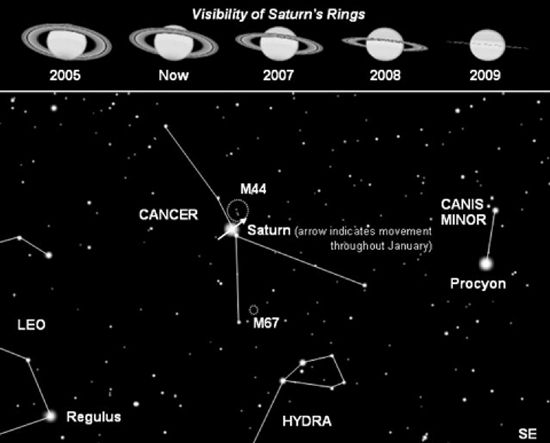Seeing Stars - Inverness Courier, Friday 6th January, 2006
A Ring-Side Seat
By Antony McEwan, Highlands Astronomical Society
Saturn makes a welcome return to our skies, and is a fine object to observe in the first nights of 2006. The sixth planet from the Sun, Saturn is the second largest in our solar system, so always shines brightly in our sky. This month Saturn is in the constellation of Cancer, close to the open cluster M44, known as the Beehive. It is fairly high in the southeast by 11pm, and slightly brighter than magnitude 0, easily visible with the naked eye.
A gas giant, Saturn consists mostly of hydrogen, with some helium and traces of methane, ammonia, rock and ice. Despite its size (120,536km equatorial diameter) Saturn would actually float on water, if you could find a bowl large enough! Saturn possesses the first and finest ring system discovered in the solar system, making it one of the most dramatic objects to observe telescopically. Most amateur telescopes should show the outer A-ring and the inner B-ring, with a black lane between them called the Cassini division. This gap was named after its discoverer, 17th century astronomer, Giovanni Domenico Cassini, and is about 4500 km wide. It is created by one of Saturn’s many moons, Mimas, exerting a gravitational force on some of the ring material, which effectively clears the gap. Inside the B-ring is the C-ring (or Crepe ring), which is less bright than rings A and B, and therefore harder to spot in a small telescope. It can be seen though, especially when the atmosphere is steady enough to use higher magnifications or when using a larger (4” aperture or more) telescope.

The rings are not always as easy to observe as they are now. Saturn’s axis of rotation is tilted at an angle of 27 degrees to the Sun, and the rings surround the planet directly above its equator. As Saturn completes one orbit of the Sun the rings become more edge-on to us until they seem to completely disappear. Then they gradually open up again. This happens twice in each Saturnian year, which is 29 Earth years long. The next time they will be edge-on is in 2009, so we should enjoy the view of the rings while we can. Cloud bands and atmospheric storms around Saturn’s disc should become more visible to observers when the rings are edge-on, so there will still be good reason to look at Saturn, even without its impressive rings. When viewing Saturn you may notice that it appears to be slightly ‘flattened’. This is due to its rapid rotational period of just 10hours 14minutes at the equator.
Teasing fine details out of the telescopic view of a planet (or any celestial object) can take some time, but there are steps you can take to make this easier. You will have noticed that it’s January, and therefore the nights are cold! Be sure to wrap up warm when going outside to observe, and that means more than just putting a heavy jacket on top. Try to wear several thin layers of clothing to trap layers of air around your body. This will preserve heat better. Now is the ideal time to dig out the thermal underwear that Santa gave you and make good use of it! Double up your socks too, and wear thick boots, fur-lined if possible to insulate your feet. You will probably be standing or sitting in one place for quite a while, so if you feel fingers or toes freezing up- jump around and swing your arms to get the circulation going and warm the extremities.
Comfort is important while observing, and if you are not able to enjoy the experience you won’t get much out of it. Sit down. Take a folding stool or chair, and use it when viewing through the telescope. You’ll be amazed how much steadier the view is when you are sat firmly in one place instead of swaying about while looking into the eyepiece. It will also reduce potential leg and backaches. Spend time planning your observing session, and make sure you have the essential items with you, including torches (red and white light), star-charts, planisphere, and whatever else you are likely to need. A flask of something warm to drink and some carbohydrates in the form of biscuits or bananas can come in handy in the cold and dark too!
It is difficult -if not impossible- to view faint deep-sky objects like galaxies and nebulae from under the hazy veil of modern lighting. If possible, find a site away from streetlights and other light sources and let your eyes adapt to the darkness. Your pupils will expand immediately but it can take half an hour or more for the more sensitive receptors in the eyes to activate fully. When adapted, your eyes will become thousands of times more sensitive to faint objects- essential for galaxy viewing. Unfortunately, this ‘dark-adaption’ can be ruined instantly by any exposure to white light, so it is useful to have a red torch for referring to charts and books, as red light doesn’t affect it.
If you are tempted out into the countryside to seek dark skies, be safe and tell someone where you are going. Dark adaption is not required for planetary viewing though, which is good news if you want to take a ring-side seat to view Saturn, yet still stay close to home.